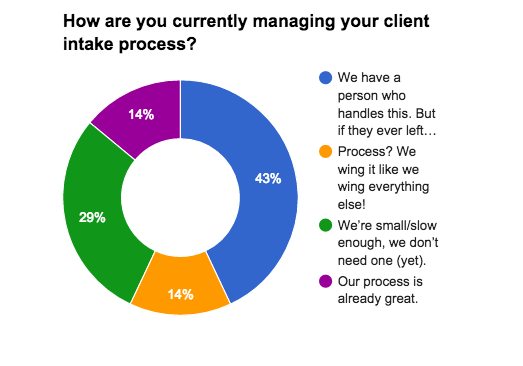Is Your New Client Onboarding Process Ready for a Makeover?

Landing a new client is always exciting. No matter how long you’ve been in business — or how big your company is — the rush of signing a brand-new client never gets old.
What comes right after, though, is often a rough spot for businesses: moving from excitement into the nuts and bolts of working together, from closing the deal to holding the first project meeting.
I get invited into agencies and companies to help them make their processes better…and this one frequently ends up at the top of the list.
This is what I hear:
- We close a new client, and then — ack! It’s always a fire drill to get the documents signed and the follow-up emails sent.
- I never can put my hands on the contracts and onboarding documents. They always seem to be in somebody else’s email inbox or hard drive and I have to track them down.
- From the client side, it might look like we have our act together, but let me tell you, we’re constantly reinventing the wheel back here.
And then there’s one of the biggest, scariest problems I hear — and this one is extra-bad, because it stops agency leaders and execs from delegating: the folks at the top land a big client, but then they stay way more involved in getting them onboarded than they should.
It’s because they don’t believe the new client will get the VIP treatment otherwise — without confidence in their onboarding processes, it’s hard to let go.
What all of this means is that agencies and companies are risking dropping the ball, disappointing their clients, wasting their execs’ time, and missing opportunities to scale.
But don’t give up hope. There is a better way, and it’s easier than you think!

5 Steps for Transforming Your Client Intake Process

Creating a smart, scalable client intake process is beneficial for everyone involved — you, your entire team, and of course the client:
- Your team can follow a smooth, streamlined process, with full visibility into what’s done and what’s due
- Your business can scale — taking on more clients and gracefully meeting the demand without breaking the bank (or overworking your team)
- Clients are delighted with the experience of working with your brand
Could your client intake process use a makeover? Read on for the 5 steps you can take to transform your current system into a streamlined, scalable process that has everybody smiling.
1. Choose a time and date for a brainstorming meeting with your team
It’s not easy to carve out time, especially when things are busy, to circle and brainstorm how to make things smooth. For some businesses, finding the time is the hardest step!
Even when people understand the value it can bring, it can still be tricky. The press of day-to-day business can feel even overwhelming, but this is the one meeting you do want to make time for. Get it scheduled!
2. Get the right people in the room
You’re shooting for a mixture of executives/management, team leads, and team members. You want attendees who can represent the client experience, as well as the team members who will be completing the work.
You also want the final result — your new client intake system — to be both aspirational and practical. The right balance of people in the meeting will make for an intake process that’s both doable for your team and delightful for clients.
3. Have a way to capture your brainstorming
If you’re all in the same room together, you can simply use a whiteboard and markers. If you’re a virtual team, you’ll want a shared document or workspace that everybody can view in real time.
During your meeting you’ll be charting a roadmap for both the client and your team, and collecting “lists of lists” of action items and deliverables. While the client onboarding process is linear, your team’s brainstorming might be anything but. Having it all visual will keep ideas organized, while not constraining any of the idea generation.
4. Commit to recording action items
During your meeting, you will surely come upon items that need to be created, documented, or brainstormed separately. You will likely identify training content you’ll want to develop and certain procedures that you’ll want fully sussed out and documented.
Your intake process won’t be fully complete until these “extra” items are completed. Capturing them all separately, so they are easy to assign, makes everything come together faster.
[cta_signup_red text=”Wish you could get more done?” subtext=”Thousands of teams use Redbooth’s easy-to-use project management platform to get more done.” placeholder=”Your email” button_link=”/signup” button_text=”Get Started FREE »”]
5. Stay focused on the process itself
You may be tempted to deep-dive on a specific item you just brainstormed — such as training content, or how exactly to explain your client review process. Resist these rabbit-holes in this main meeting. Collect these items and assign them out for later work (see #4 above).
Of course, if you can address something quickly, then do it. Coming to a quick consensus on regular response times or business hours is great — but brainstorming the entire escalation procedure for emergencies is not! Once you identify topics that require further discussion, put them aside and make plans to address them after the meeting.
I’ve seen client intake meetings galvanize businesses. More than just creating a coherent intake system, this process sparks deep empathy for the client experience and often leads to enhancements that weren’t on the radar before. (I’ve even seen it lead to new product or service ideas!)
When you’re ready for your meeting, you can use the agenda below to inspire you.
Ready to Go? Here’s Your Brainstorming Meeting Agenda

Here are the steps in the intake process that you’ll need to brainstorm:
I. Initial Steps: Start things off right
Let’s begin with Yes! The client’s yes, that is. Think back to the moment when they first begin to turn from prospect to client.
List all the steps that will need to happen as you complete a sale: from the initial verbal yes to the signed agreement. Itemize critical steps such as nailing down the statement of work, signing agreements and sending invoices, and while you’re at it, make a list of all the documents, emails and attachments you’ll need, too. The first step to smooth operations is a plan to get the deal closed smoothly, with all the right things in order.
II. Internal Systems: Set up your systems to receive your new client
Now, think about your internal systems and make sure they’re set up to start work with your client. Make a list of all the systems or software — such as invoicing, project management, time tracking — you need to add your new client to.
Document storage and naming conventions for folders and files go here as well. These steps are often overlooked (until they’re suddenly needed), and intentional up-front planning here can pay dividends later in the project.
III. Internal Project Management: Plan for project kickoff that sets you up for success
Next, you want to begin to plan and strategize — prioritizing this work with the existing workload, identifying the work team, calling the first meeting and building out the project plan.
Don’t wait for the first milestone to creep up — team formation, project planning, and kickoff meetings are best handled when momentum is high and time is at its most flexible.
IV. Client Onboarding and Training: Educate them on what it’s like to work with your team
Now you want to turn your attention to the client experience. Think client training is a necessary evil? Au contraire. Clients don’t just buy the end product, they buy the whole experience of working with you. Now is the time to differentiate yourself from your competitors and let your clients know that they’re in good hands.
What systems or procedures will your clients need to be familiar with to work with you? Don’t just sent them links to a knowledge base — shoot a step-by-step video that introduces the specific use-case. Custom training feels…custom. Your clients will notice and appreciate it.
V. Welcome Packet: Impress and delight!
What can manage expectations and solve problems before they start? A beautifully branded PDF — customized with your client’s name — that outlines procedures, deadlines, expectations and routines. This, friends, is the Welcome Wagon that simplifies your life.
What information goes in the Packet? Brainstorm everything you “wish clients knew” about your business or the work ahead, including past areas of confusion or mismatched expectations. Populate it wisely, and it does double-duty with impressing your client and lightening your workload.
Don’t miss a step! When you’re ready to hold your brainstorming meeting, use the free Client Intake Process template to guide you through the agenda.